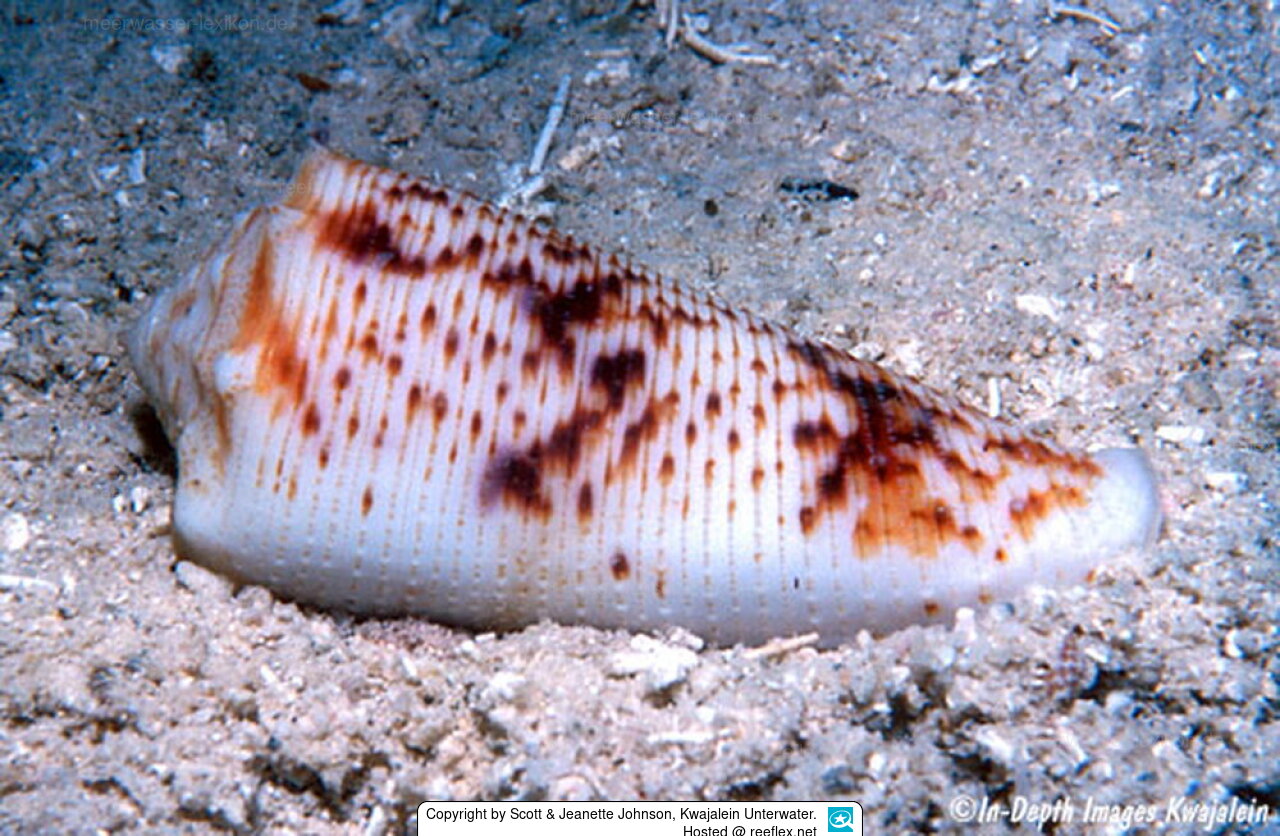Info
Like all species within the genus Conus, the Molucca cone is predatory and venomous.
Synonymised names:
Conus (Phasmoconus) moluccensis Küster, 1838 · alternate representation
Conus grondini Larue, 1995 · unaccepted (unavailable name: proposed...)
Conus moluccensis moluccensis Küster, 1838 · unaccepted
Fulgiconus moluccensis (Küster, 1838) · unaccepted
Fulgiconus moluccensis f. merletti (Mayissian, 1974) · unaccepted (unavailable name: infrasubspecific rank)
Phasmoconus merleti (Mayissian, 1974) · unaccepted
Phasmoconus moluccensis (Küster, 1838) · unaccepted
Direct children (4):
Forma Conus moluccensis f. merletti Mayissian, 1974 accepted as Conus merletti Mayissian, 1974 (unaccepted > superseded combination)
Subspecies Conus moluccensis marielae Rehder & B. R. Wilson, 1975 accepted as Conus marielae Rehder & B. R. Wilson, 1975
Subspecies Conus moluccensis moluccensis Küster, 1838 accepted as Conus moluccensis Küster, 1838
Subspecies Conus moluccensis vappereaui Monteiro, 2009 accepted as Conus vappereaui Monteiro, 2009 (unaccepted > superseded combination)
The genus Conus, which belongs to the family Conidae, is a group of predatory snails.
Between 800 to 1000 different cone snails live in our oceans and are carnivorous.
"Slow as a snail" is a bknown exclamation, how can the slow moving cone snails capture carnivorous food animals?
The venom of cone snails is so potent that it can instantly paralyze and eventually kill prey
These snails detect prey in their environment using an appendage called a siphon. While some species have an eyestalk, the siphon is a more sensitive method of locating prey and also performs additional respiratory functions. The prey that each Conus species hunts varies greatly. Some feed on worms (vermivores), others on mollusks (molluscivores), and the species most toxic to humans feed on fish (piscivores).
The venom of the cone snail is a complex mixture of compounds that cause paralysis through several neuromuscular blocking steps. The combinations of peptides that make up the venom vary from species to species, and it is estimated that each cone snail contains over 100,000 different bioactive compounds in its venom. The complexity of this venom and the different target pathways have prevented the production of an effective antitoxin.
The cone snail's habitats primarily include tropical waters, such as the Red Sea, Caribbean Sea, Indian Ocean, and Pacific Ocean. Despite their preference for tropical environments, cone snails also live in warm deep-sea waters off the coast of Florida. They generally live in the deep sea near reefs and hunt mainly at night. During the day, they bury themselves in the sand and primarily encounter humans only when provoked. Various sources report mortality rates ranging from 15% to 75%, but it remains to be noted that cone snail poisoning is a preventable cause of death that all deep-sea divers should be aware of.
Because of the rarity of cone snail poisoning and the lack of data, it is uncertain whether death is due to respiratory toxicity, cardiovascular toxicity, or a combination of both. The effects of poisoning depend on the specific peptides in the venom and are therefore largely unpredictable. These venoms have a variety of neuromuscular effects- via glutamate, adrenergic (chi-conotoxin), serotonin, and cholinergic pathways.
There are several "conotoxins" in species-specific combinations in snail venom. These toxins have a variety of neuromuscular effects via glutamate, adrenergic (chi-conotoxin), serotonin, and cholinergic pathways. Some conotoxins exert their effects on sodium (delta-conotoxin), potassium, and calcium ion channels. In addition, there are other less well-known targets, such as toxins that act on hormone receptors and simulate the effects of oxytocin and vasopressin (conopressins). Another major component of cone snail venom is various alpha-conotoxins. These toxins act specifically on nicotinic receptors responsible for skeletal muscle contraction. This mechanism is similar to that of botulinum toxin in that they act on the same signaling pathway. Alpha-conotoxins block nicotinic receptors, resulting in paralysis that can also affect the diaphragm. Because of the wide range of molecular targets and the different toxins of each Conus species, it is virtually impossible to produce an effective antidote.
The most important action following cone snail intoxication is urgent hospital treatment and ensuring that the patient's airway, breathing, and circulation remain intact. Once the patient arrives at the hospital, mechanical ventilation and supportive therapies are initiated. During transport, some additional methods may be used to prevent spread of the toxin. Pressure immobilization involves bandaging the limb, starting at the distal end (fingers or toes) and moving toward the axial joints. This technique was suggested to prevent further injury after poisoning. The bandage should be tight, but not so tight as to interfere with blood flow. Frequent examinations should ensure that the most distal parts (i.e., fingers, toes) remain pink. It is recommended that these dressings be removed for 90 seconds and reapplied every 10 minutes, but this should not affect the speed of transport to a hospital in any way.
Other reports suggest that hot water (40 to 50 degrees Celsius) may be effective for pain relief after cone snail intoxication. More reports are needed before this becomes standard treatment, but at this time they are based mainly on anecdotal data.
Source:
https://www.ncbi.nlm.nih.gov/books/NBK470586/







 Scott & Jeanette Johnson, Kwajalein Unterwater
Scott & Jeanette Johnson, Kwajalein Unterwater





























































































